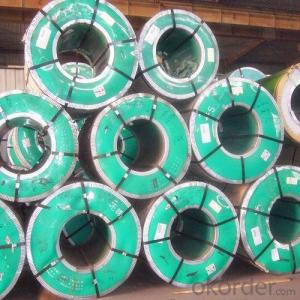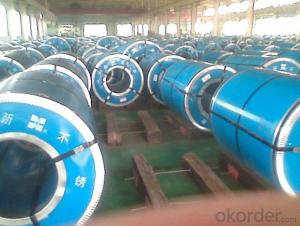Stainless Steel Coil 304 Hot Rolled Wide / Narrow No.1 Surface Finish
- Loading Port:
- Guangzhou
- Payment Terms:
- TT OR LC
- Min Order Qty:
- 100 m.t.
- Supply Capability:
- 8000 m.t./month
OKorder Service Pledge
OKorder Financial Service
You Might Also Like
Grade: | 300 Series | Standard: | JIS,AISI,ASTM,GB,DIN,EN etc | Thickness: | 2.5mm, 3.0mm, 4.0mm |
Width: | 550mm-1500mm | Length: | according to weight | Place of Origin: | China (Mainland) |
Brand Name: | CNBM | Model Number: | 304 | Technique: | Hot Rolled |
Application: | industry, construction, furniture, repairing | Certification: | MTC | Finishing: | NO.1 |
Market: | globle area | Packaged: | wooden and bags in cases as standard | Payment: | TT & LC |
Delivery time: | 15 days | MOQ: | 100 tons | Advantage: | prime quality, competitive price |
Profession: | hot rolled | Charactor: | stainless steel coils | Material/Grade: | 304 |
Hot Rolled Stainless Steel Coil 304 Annealing and Pickling No.1 Finish
Stainless steel is a production which not easy rust,acid resistance and corrosion resistance,so it is widely
used in light industry,heavy industry,daily necessities and the decoration industry.
Hot Rolled Stainless Steel Coil 304 Specifications
1.surface:NO.1
2.standard:JIS, AISI, GB
3.width: 0.55m, 0.65m, 1.0m, 1.22m, 1.5m, 2m or requirement
Hot Rolled Stainless Steel Coil 304 Chemical Composition:
(%):C=0.07, Mn=2.00, P=0.045, S=0.030, Si=0.075, Cr=17.5-19.5, Ni=8.0-10.5, N=0.10
Hot Rolled Stainless Steel Coil 304 Physical Properties
Tensile strength σb (MPa) ≥ 520
the conditions yield strength σ0.2 (MPa) ≥ 205,
elongation δ5 (%) ≥ 40
Reduction of ψ (%) ≥ 50,
hardness: ≤ 187
HB; ≤ 90
HRB; ≤ 200H
- Q:Are stainless steel strips available in different widths?
- Indeed, diverse widths of stainless steel strips can be obtained. These strips find widespread usage in multiple sectors, namely construction, automotive, and manufacturing. They are offered in a wide array of widths, catering to distinct project specifications. The width choices encompass slender strips, typically measuring approximately 0.5 inches or less, as well as broader strips that can extend to several inches or even more. The provision of various widths facilitates enhanced adaptability in the design and construction of diverse applications.
- Q:Are stainless steel strips suitable for marine applications?
- Stainless steel strips prove to be an ideal choice for marine applications due to their remarkable resistance against corrosion. This characteristic stems from the well-known corrosion resistance of stainless steel, which makes it a favored material for marine settings that frequently encounter saltwater, humidity, and other corrosive elements. The outstanding strength and durability of stainless steel strips enable them to withstand the demanding conditions, elevated temperatures, and mechanical strain commonly experienced in marine applications. Alongside these advantages, stainless steel's minimal maintenance demands and aesthetic appeal contribute to its widespread usage in various marine elements like boat fittings, marine hardware, marine fasteners, and shipbuilding.
- Q:How do stainless steel strips perform in acidic environments?
- Stainless steel strips are highly resistant to corrosion in acidic environments due to the presence of chromium in its composition, which forms a protective oxide layer. This layer prevents the steel from reacting with acids, ensuring excellent performance and durability even in highly acidic conditions.
- Q:Are 111 stainless steel strips suitable for cryogenic storage containers?
- Yes, 111 stainless steel strips are suitable for cryogenic storage containers.
- Q:Can stainless steel strips be customized?
- Certainly! Stainless steel strips have the capacity for customization. Stainless steel, being a versatile material, lends itself easily to cutting, shaping, and forming in accordance with particular requirements. One can opt for customization in various ways, such as slicing the strips into specific dimensions, molding them into curves or angles, and incorporating additional elements like holes, notches, or slots. Moreover, customization options extend to surface finishes, encompassing brushed, polished, or embossed finishes. Furthermore, different grades of stainless steel are accessible, each boasting unique properties and characteristics, thereby allowing for additional customization to fulfill specific needs such as resistance to corrosion, strength, or heat. Overall, stainless steel strips provide an extensive array of possibilities for customization to suit diverse applications and industries.
- Q:Can stainless steel strips be used for automotive fasteners?
- Yes, stainless steel strips can be used for automotive fasteners. Stainless steel is a durable and corrosion-resistant material, making it suitable for various automotive applications, including fasteners.
- Q:What is the difference between cold rolled and hot rolled stainless steel strips?
- The manufacturing processes and resulting properties of cold rolled and hot rolled stainless steel strips are different. To produce cold rolled stainless steel strips, the stainless steel is passed through a series of rollers at room temperature. This process creates a thinner and more precise strip with a smooth and shiny surface finish. Additionally, cold rolling strengthens and hardens the stainless steel, making it suitable for applications that require high strength and a polished appearance. Furthermore, cold rolled stainless steel strips have better dimensional accuracy and straightness compared to hot rolled strips. On the contrary, hot rolled stainless steel strips are manufactured by heating the stainless steel slab or billet to a high temperature and then rolling it through a series of rolling mills. This process results in a thicker and less precise strip with a rough and scaled surface finish. Hot rolling is preferred for applications that do not require a high level of precision or a polished appearance, such as structural applications or manufacturing processes that involve further shaping or forming of the stainless steel strip. Regarding properties, cold rolled stainless steel strips have higher tensile strength and yield strength than hot rolled strips. They also exhibit better corrosion resistance, as the cold rolling process refines the microstructure, reducing the presence of defects and impurities. However, hot rolled stainless steel strips have higher ductility and are more easily formable due to the higher temperature processing. In conclusion, the choice between cold rolled and hot rolled stainless steel strips depends on specific application requirements, such as the desired surface finish, dimensional accuracy, strength, and formability.
- Q:How are 111 stainless steel strips manufactured?
- 111 stainless steel strips are manufactured through a series of processes including melting, casting, rolling, annealing, pickling, and slitting. Initially, stainless steel is melted in a furnace and then cast into large slabs. These slabs undergo hot rolling, where they are passed through multiple sets of rollers to reduce their thickness and achieve the desired width. Subsequently, the strips are annealed to relieve stress and improve ductility. After annealing, the strips are pickled to remove any oxides or impurities on the surface. Finally, the pickled strips are slit into individual strips of the desired width using specialized machinery.
- Q:What are the dimensions and thicknesses available for stainless steel strips?
- The available dimensions and thicknesses for stainless steel strips differ based on the specific requirements and application. The widths of stainless steel strips commonly range from 1/2 inch to 48 inches, while the thicknesses vary from 0.001 inch to 0.1875 inch. It is important to keep in mind that these dimensions can be tailored to meet the specific needs of a project. Specialized applications may even offer wider or thicker stainless steel strips from certain manufacturers. Moreover, the length of stainless steel strips can vary, typically ranging from a few feet to hundreds of feet, depending on the supplier and customer requirements. To determine the precise dimensions and thicknesses available for stainless steel strips for your specific project, it is always advisable to consult with a stainless steel supplier or manufacturer.
- Q:Why does the stainless steel after processing have magnetism?
- The austenite is non-magnetic or weakly magnetic, and martensite or ferrite is magnetic, a tripod of stainless steel processing in processing time due to melting segregation or improper heat treatment, will cause a small amount of martensite Austenitic 304 stainless steel body or ferrite. In this way, 304 stainless steel will have a weak magnetic.
1. Manufacturer Overview |
|
|---|---|
| Location | |
| Year Established | |
| Annual Output Value | |
| Main Markets | |
| Company Certifications | |
2. Manufacturer Certificates |
|
|---|---|
| a) Certification Name | |
| Range | |
| Reference | |
| Validity Period | |
3. Manufacturer Capability |
|
|---|---|
| a)Trade Capacity | |
| Nearest Port | |
| Export Percentage | |
| No.of Employees in Trade Department | |
| Language Spoken: | |
| b)Factory Information | |
| Factory Size: | |
| No. of Production Lines | |
| Contract Manufacturing | |
| Product Price Range | |
Send your message to us
Stainless Steel Coil 304 Hot Rolled Wide / Narrow No.1 Surface Finish
- Loading Port:
- Guangzhou
- Payment Terms:
- TT OR LC
- Min Order Qty:
- 100 m.t.
- Supply Capability:
- 8000 m.t./month
OKorder Service Pledge
OKorder Financial Service
Similar products
New products
Hot products
Hot Searches
Related keywords






























